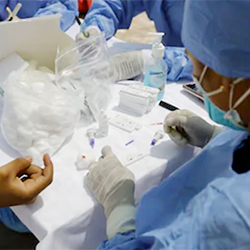Johns Hopkins researchers found that testing for SARS-CoV-2 too early in the course of infection is likely to result in false-negative test results, even though the patient may eventually test positive for the virus (Ann Intern Med 2020 May 13. [Epub ahead of print]).
For the new analysis, Johns Hopkins Medicine researchers reviewed reverse transcriptase–polymerase chain reaction (RT-PCR) test data from seven prior studies, including two preprints and five peer-reviewed articles. The studies covered a combined total of 1,330 respiratory swab samples from a variety of people, including hospitalized patients and those identified through contact tracing in an outpatient setting.
Using RT-PCR test results, along with reported time of exposure to the virus or time of onset of measurable symptoms—such as fever, cough and breathing problems—the researchers calculated the probability that someone infected with SARS-CoV-2 would have a negative test result when they had the viral infection. In the published studies, health care providers collected nasal and throat samples from patients and noted the time of virus exposure or symptom onset and sample collection.

From these data, the Johns Hopkins researchers calculated daily false-negative rates. The researchers estimated that those tested with SARS-CoV-2 in the four days after infection were 67% more likely to test negative, even if they had the virus (CI, 27% to 94%). When the average patient began displaying symptoms of the virus, the false-negative rate was 38%. The test performed best eight days after infection (on average, three days after symptom onset), but even then had a false-negative rate of 20% (CI, 13% to 31%).
“We are using these tests to rule out COVID-19, and basing decisions about what steps we take to prevent onward transmission, such as selection of personal protective equipment for health care workers,” said Lauren Kucirka, MD, PhD, MSc, an obstetrics and gynecology resident at Johns Hopkins Medicine, in Baltimore.
She added that as businesses and other venues begin to open, and America comes out of quarantine, it is important to recognize the limitations of the COVID-19 tests. “A negative test, whether or not a person has symptoms, doesn’t guarantee that they aren’t infected by the virus,” she added. “How we respond to, and interpret, a negative test is very important because we place others at risk when we assume the test is perfect.”
Patients with a high-risk exposure should be treated as if they are infected, particularly if they have symptoms consistent with COVID-19, she said. This means communicating with patients about the tests’ shortcomings.
One of several ways to assess for the presence of SARS-CoV-2 infection is RT-PCR tests, which rapidly make copies of and detect the virus’s genetic material. However, as shown in tests for other viruses such as influenza, if a swab misses collecting cells infected with the virus, or if virus levels are very low early during the infection, some RT-PCR tests can produce negative results. Since the tests return relatively rapid results, they have been widely used among high-risk populations, such as nursing home residents, hospitalized patients and health care workers. Previous studies have shown or suggested false negatives in these populations.
Ongoing efforts to improve tests and better understand their performance in a variety of contexts will be critical as more people are infected with the virus and more testing is required. The sooner people can be accurately tested and isolated from others, the researchers said, the better we can control the spread of the virus.
—Clinical Oncology News Staff

